 I knew today was going to be rough — my body does not do well in the heat, and it was supposed to be hot today — “Increased heat stress must be expected,” according to the German version of Weather Underground. It was supposed to get to around 90 today, and we only have so much time to be in Austria, so sitting out a hot spell was not really an option, and there are only so many salt mines to visit, so it was going to be a hot day.
I knew today was going to be rough — my body does not do well in the heat, and it was supposed to be hot today — “Increased heat stress must be expected,” according to the German version of Weather Underground. It was supposed to get to around 90 today, and we only have so much time to be in Austria, so sitting out a hot spell was not really an option, and there are only so many salt mines to visit, so it was going to be a hot day.
 Up front, I have to give Meredith a ton of credit. She knows how badly I do in the heat, and she did everything she could to help me today. She walked in the shadows, and read from our Rick Steves tour book in the shade. She let me rest and eat something twice in cafes during the day. When I got really bad late in the afternoon, she was patient while I sat in the shade not moving for about ten minutes, and then we went inside to a museum. She is a trooper; I did my best to stay upbeat.
Up front, I have to give Meredith a ton of credit. She knows how badly I do in the heat, and she did everything she could to help me today. She walked in the shadows, and read from our Rick Steves tour book in the shade. She let me rest and eat something twice in cafes during the day. When I got really bad late in the afternoon, she was patient while I sat in the shade not moving for about ten minutes, and then we went inside to a museum. She is a trooper; I did my best to stay upbeat.
Enough of that — it was hot, and I struggled late in the day. For the actual touring part of the day, we saw Salzburg. All of it. At least that is what it seemed like — we walked all over the old town area all day, so we covered a lot of it.
 We started the day with a real treat for me — we toured a working town glockenspiel. Near the cathedral are the residence halls of the prince/archbishops who ruled Salzburg for five hundred years. The New Residence (from the 1600s) was outfitted with a glockenspiel (hammered bells that play a tune — think a huge music box) around 1700. Twice per week you can actually tour the entire thing — the mechanism and the bells — and see it playing when it runs at 11:05 am.
We started the day with a real treat for me — we toured a working town glockenspiel. Near the cathedral are the residence halls of the prince/archbishops who ruled Salzburg for five hundred years. The New Residence (from the 1600s) was outfitted with a glockenspiel (hammered bells that play a tune — think a huge music box) around 1700. Twice per week you can actually tour the entire thing — the mechanism and the bells — and see it playing when it runs at 11:05 am.
We had a tour of five — me and Meredith, a German-speaking couple, and a woman from near Toronto. Our guide was a young woman from southern Germany, and she did a great job giving the tour both in English and in German. We got to climb up two flights of stairs in the highly ornate stairwell of the New Residence hall, then we climbed up a wooden staircase to a heavy door opened with a heavy key, which led up another set of wooden steps to the mechanism, which was huge. The giant wheel which plays the tune has 8,000 holes in it, and they change out bolts in these holes once a month to change the tunes. The bolts hit little hammers, which yank on wires, which go up to hammers on the individual bells, and the hammers hit the bells. It is all genius, and it was all run by a clockwork mechanism that was wound three times per day until it was bypassed for an electric motor. Very cool.
After we got to see the glockenspiel wheel in action, we climbed up a ladder to the roof, for spectacular views of Salzburg and close-up views of the 35 bells and their individual hammer wires. It was high enough (about a hundred feet) that I mostly looked at the bells, but I managed to glance at the city a few times.
 After we climbed back down and ended the tour, Meredith had us set off on Rick Steves’ recommended old town walking tour. The walk takes you past most of the important sights in the city, which is fun to wander around in — lots of squares, interesting streets, tons of people to watch, great churches, natural beauty all around. We saw a ton of things, of which I’ll cover the places we actually stopped in to look around.
After we climbed back down and ended the tour, Meredith had us set off on Rick Steves’ recommended old town walking tour. The walk takes you past most of the important sights in the city, which is fun to wander around in — lots of squares, interesting streets, tons of people to watch, great churches, natural beauty all around. We saw a ton of things, of which I’ll cover the places we actually stopped in to look around.
We first stopped in at the cathedral. It is huge, as you might expect a cathedral to be. This cathedral is from the early 1600s, replacing one that burned down. It was built fairly quickly, taking less than twenty years, so the the inside and outside of the church are all of one style. The inside is mostly white, with elaborate stucco work and magnificent paintings on the ceiling and domes. The church has five organs, so music still plays an important part in Sunday services, even today.
We then meandered over to St. Peter’s Cemetery. Meredith and I have an interest in cemeteries in that they tend to be in beautiful places, and seeing the graves can be interesting — the individual nature of the headstones, memorials to the loved one, and so on. In addition to all of these things, this cemetery has a staircase inside the cliff that leads to two chapels that were (supposedly) used by cliff-dwelling hermits. After we looked in the cliff chapels, we also went in to St. Peter’s Church, which is no small church itself. It is a little darker inside than the cathedral, but it still has a lot of art inside.
 We made our way over to the old market street and walked down to the house where Mozart was born. I’m sheepish to admit our main motivation for going inside was to use the bathroom (the public bathrooms were closed), but we did go through the house and read about Mozart’s family life, which was interesting to me. I was not aware that he had a very talented sister who toured with Mozart and their father until she was 17 years old.
We made our way over to the old market street and walked down to the house where Mozart was born. I’m sheepish to admit our main motivation for going inside was to use the bathroom (the public bathrooms were closed), but we did go through the house and read about Mozart’s family life, which was interesting to me. I was not aware that he had a very talented sister who toured with Mozart and their father until she was 17 years old.
After Mozart’s house we took the funicular up to the astonishingly massive castle on top of the hill/cliff overlooking the old town. It takes up over eight acres and has over fifty buildings, and multiple levels of walls and defenses. It was never attacked, which was probably what the prince/archbishop was hoping for during the Thirty Years’ War and other potential conflicts.
 The castle has several things to see — a tower tour that we took, which involved a lot of stairs and spectacular views for Meredith while I stayed safely back from the edge. It has some small museums that we visited as well. There were the prince’s rooms, which are all decked out as they think they were back in the 1400s. We toured a museum on an Austrian regiment that was stationed at the castle at one point, which Meredith found particularly interesting since they fought on the Italian front in World War One (Meredith teaches a book about World War One from the perspective of a German soldier). There was a very cool armor display, where the armor was all in action/attacking poses, held up by wires, including shot arrows and cannon balls. We saw some models of the fortress over the centuries, and a wonderfully fun mechanical theater show about the archbishop from the fifteenth century who made Salzburg into an economic powerhouse. We even checked out the small marionette museum on the grounds.
The castle has several things to see — a tower tour that we took, which involved a lot of stairs and spectacular views for Meredith while I stayed safely back from the edge. It has some small museums that we visited as well. There were the prince’s rooms, which are all decked out as they think they were back in the 1400s. We toured a museum on an Austrian regiment that was stationed at the castle at one point, which Meredith found particularly interesting since they fought on the Italian front in World War One (Meredith teaches a book about World War One from the perspective of a German soldier). There was a very cool armor display, where the armor was all in action/attacking poses, held up by wires, including shot arrows and cannon balls. We saw some models of the fortress over the centuries, and a wonderfully fun mechanical theater show about the archbishop from the fifteenth century who made Salzburg into an economic powerhouse. We even checked out the small marionette museum on the grounds.
That ended our touring for the day. After a supper in a restaurant near the castle, we walked back to the river, where we watched it and people pass by until out bus showed up and took us home as the day finally cooled off.
All of it, huh? Did you see the creepy St Sebastian cemetery across the river? It’s in a courtyard and has all kinds of elaborate, creepy carved headstones and huge memorial pantings (some also super creepy).
Love it.
http://www.atlasobscura.com/places/st-sebastian-s-cemetery
We only got across the river on the first night to walk the medieval town’s main street, so we missed that.
Too bad. One of the more sobering cemeteries I’ve seen. Momentus mori, indeed.